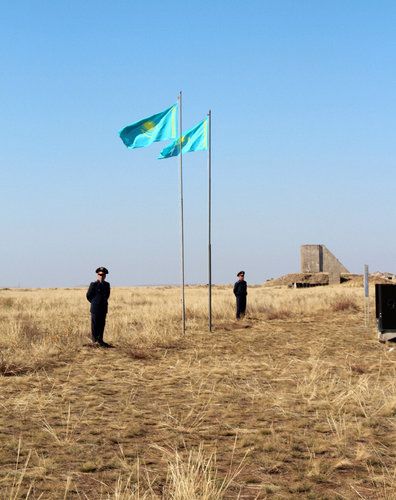 Soldiers near the center of the former Soviet nuclear test site in Semipalatinsk, Kazakhstan.
Soldiers near the center of the former Soviet nuclear test site in Semipalatinsk, Kazakhstan.
Working in top secret over a period of 17 years, Russian and American scientists collaborated to remove hundreds of pounds of plutonium and highly enriched uranium — enough to construct at least a dozen nuclear weapons — from a remote Soviet-era nuclear test site in Kazakhstan that had been overrun by impoverished metal scavengers, according to a report released last week by the Belfer Center for Science and International Affairs at Harvard.
The report sheds light on a mysterious $150 million cleanup operation paid for in large part by the United States, whose nuclear scientists feared that terrorists would discover the fissile material and use it to build a dirty bomb.
Over the years, hints emerged that something extraordinarily dangerous had been left behind in a warren of underground tunnels — like the American aerial drones that circled over the site, looking for intruders, or the steel-reinforced concrete that was poured into tunnels and over stretches of earth.
Among the report’s new revelations is that the Soviet testers left behind components, including high-purity plutonium, that could have been used to build not just a dirty bomb but a “relatively sophisticated nuclear device,” an American official told the report’s authors.
American scientists spent years trying to coax information about Soviet-era testing from their counterparts in Russia.
It was a white-knuckle effort at times, since local scavengers in search of scrap metal were regularly digging “within yards” of the fissile material.
Siegfried S. Hecker, a former director of the Los Alamos National Laboratory, described his astonishment when he first visited the site in 1998, cruising past unattended gates.
“When I went out there, I was expecting to see guys on camels, pulling on copper cables,” Mr. Hecker told the authors. Instead, he saw miles of trenches that had been dug by teams with excavating machines — evidence of what he called “a major industrial enterprise,” which dug up miles of irradiated copper cable and sold it to Chinese dealers.
Mr. Hecker concluded that the site contained nuclear material “in reasonably concentrated form, easily picked up, completely open to whoever wants to come.”
The report describes a project driven forward almost entirely by Russian and American scientists, without the “elaborate, negotiated state-to-state agreements of the kind used for arms control during the cold war.”
Mr. Hecker said he understood his counterparts’ reluctance; the mixture of plutonium isotopes used in Russian nuclear bombs was a closely guarded secret that Americans might discover if they gained access to the tunnels.
Mr. Hecker recalled going to a small city in Russia for an informal meeting with Radi Ikayev, director of the first Soviet nuclear-weapons laboratory, and showing him photographs of the excavating that was going on at the site, in Semipalatinsk.
“Radi was just silent,” Mr. Hecker recalled. “He just looked at me, and looked at the photos. And he said, ‘I’ll have someone talk to you in the morning.’ ”
From that point onward, a handful of Russian scientists began sharing information about the site. Underneath a formation called Degelen Mountain, 209 nuclear tests had been carried out in 181 tunnels, coating the earthen walls with plutonium residue; but not all the devices had detonated. Pure plutonium and highly enriched uranium remained, in chunks or inside the duds.
The Russians also knew about explosions that had been set off inside large metal containers called Kolbas, some of which had been left deep within the maze of tunnels.
Mr. Hecker then showed the same photographs to high-level American officials, warning them that scavengers could recover as much as 440 pounds of plutonium at the site.
In 1999, on the margins of an international nonproliferation conference, the United States agreed to finance the cleanup effort; Russia agreed to provide information and scientists, and Kazakhstan to do the fieldwork. The signers celebrated their agreement with vodka toasts, beginning a project that would stretch on for more than 10 years, as scavengers penetrated closer to fissile material. Step by step, the team began encasing the fissile material in concrete, rendering it virtually unusable in a bomb.
When a New York Times reporter visited the site in 2011, the effort was shrouded by a heavy veil of secrecy.
“People ask me, are we doing the right thing, closing access to the tunnels?” said the official overseeing the test site, Kairat K. Kadyrzhanov, general director of the National Nuclear Center, at the time. “And I say I do not know what is there, and I do not have the right to know.”
The effort had a year and a half to go at that point. In October 2012, Mr. Kadyrzhanov was one of a small group of scientists — American, Russian and Kazakh — who gathered for a picnic to mark the completion of the cleanup. A monument now stands at the site, with the inscription: “1996-2012. The world has become safer.”
 В Атырау -1
В Атырау -1